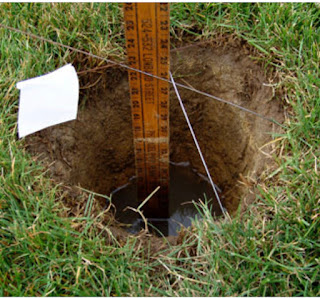
If you’re building in the country, something you might not know is when build a new house you also have to install a wastewater system – or a place for all your wastewater to go. In town, there is plumbing and city sewers to take care of all that, but if you build in the country you have to provide your own sewer system! The most popular types of wastewater systems are septic systems.
Septic systems work in conjunction with Mother Nature. The largest part of a septic system is the drain field (also known as a lateral field or leach field). The drain field is the portion of your septic system that uses the soil to absorb ALL of the water that comes out of your house. Every time you flush, do a load of laundry, take a shower, run the dishwasher, wash your hands, etc., the water drains out of the house and eventually ends up in the soil right outside.
But there’s actually a little more involved with where your septic system is placed and what kind of soil is best at absorbing water….
Before you can even put a conventional septic system in the ground, you have to have a percolation test (perc test for short). It is the most exciting process ever….a certified installer comes out to your land and drills holes (usually 3-6 holes 30 inches deep) in the ground. Next, he fills them with water. Then he watches the water absorb into the soil. FASCINATING, right? Great time on a Friday night? Well, maybe not. Actually, this is probably as fun as watching water boil, but unfortunately it is the process we have to conduct to find out if a septic system can be installed on your land.

If the per tests “passes,” a conventional septic system can be installed. If it “fails,” you have to look at other options (i.e. lagoon, polishing pond, or engineered system). The bigger issue here is this: where ever that perc test was taken, if it passes, THAT AREA AND THAT AREA ONLY is where the drain field portion of your septic system needs to be installed.
What exactly do I mean by that?
Let’s say you’re purchasing a 3 acre plot – which is pretty common in our area. If you have a passing perc test on that lot, it does not mean that ALL THE SOIL on that lot is good. It only means the soil where the test was taken is good. The crazy thing about soils is that they change fast. In one 3 acre plot, you can have up to 4 different types of soil flowing through it. So, when you get a passing perc rate, bear in mind, that it’s only where that test was taken and NO WHERE ELSE. We have seen people build right on top of the only good soil on their lot which is terribly unfortunate. When we conduct a perc test, we not only mark our holes with flags, but we give you a GIS map with the results so you can see where the test was taken.
So, though this may be quite possibly the most boring work a person can think of….conducting a perc test…it is vital and important when installing a conventional septic system.
Hope this is helpful! Until next week!
